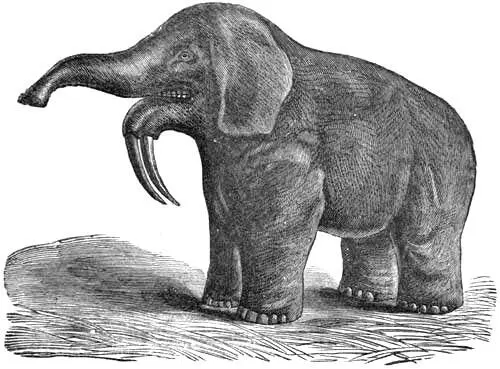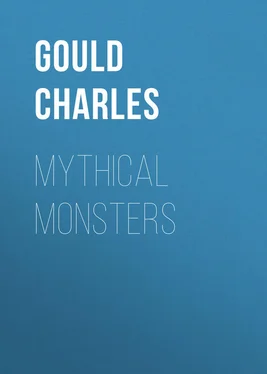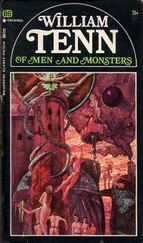Charles Gould - Mythical Monsters
Здесь есть возможность читать онлайн «Charles Gould - Mythical Monsters» — ознакомительный отрывок электронной книги совершенно бесплатно, а после прочтения отрывка купить полную версию. В некоторых случаях можно слушать аудио, скачать через торрент в формате fb2 и присутствует краткое содержание. Жанр: Мифы. Легенды. Эпос, Природа и животные, foreign_antique, foreign_prose, на английском языке. Описание произведения, (предисловие) а так же отзывы посетителей доступны на портале библиотеки ЛибКат.
- Название:Mythical Monsters
- Автор:
- Жанр:
- Год:неизвестен
- ISBN:нет данных
- Рейтинг книги:5 / 5. Голосов: 1
-
Избранное:Добавить в избранное
- Отзывы:
-
Ваша оценка:
- 100
- 1
- 2
- 3
- 4
- 5
Mythical Monsters: краткое содержание, описание и аннотация
Предлагаем к чтению аннотацию, описание, краткое содержание или предисловие (зависит от того, что написал сам автор книги «Mythical Monsters»). Если вы не нашли необходимую информацию о книге — напишите в комментариях, мы постараемся отыскать её.
Mythical Monsters — читать онлайн ознакомительный отрывок
Ниже представлен текст книги, разбитый по страницам. Система сохранения места последней прочитанной страницы, позволяет с удобством читать онлайн бесплатно книгу «Mythical Monsters», без необходимости каждый раз заново искать на чём Вы остановились. Поставьте закладку, и сможете в любой момент перейти на страницу, на которой закончили чтение.
Интервал:
Закладка:
29
“In the next place, we must remember how impossible it is for the mind to invent an entirely new fact. There is nothing in the mind of man that has not pre-existed in nature. Can we imagine a person, who never saw or heard of an elephant, drawing a picture of such a two-tailed creature?” – J. Donelly, Rangarok , p. 119. New York, 1883.
30
“I conceive that quite a large proportion of the most profound thinkers are satisfied to exert their memory very moderately. It is, in fact, a distraction from close thought to exert the memory overmuch, and a man engaged in the study of an abstruse subject will commonly rather turn to his book-shelves for the information he requires than tax his memory to supply it.” – R. A. Proctor, Pop. Sci. Monthly , Jan. 1874.
31
“It was through one of these happy chances (so the Brothers Grimm wrote in 1819) that we came to make the acquaintance of a peasant woman of the village of Nieder-Zwehrn, near Cassel, who told us the greater part of the Märchen of the second volume, and the most beautiful of it too. She held the old tales firmly in her memory, and would sometimes say that this gift was not granted to everyone, and that many a one could not keep anything in its proper connection. Anyone inclined to believe that tradition is easily corrupted or carelessly kept, and that therefore it could not possibly last long, should have heard how steadily she always abided by her record, and how she stuck to its accuracy. She never altered anything in repeating it, and if she made a slip, at once righted herself as soon as she became aware of it, in the very midst of her tale. The attachment to tradition among people living on in the same kind of life with unbroken regularity, is stronger than we, who are fond of change, can understand.” — Odinic Songs in Shetland. Karl Blind, Nineteenth Century , June 1879.
32
See quotation from Gladstone, Nineteenth Century , Oct. 1879.
33
Mr. C. P. Daly, President of the American Geographical Society, informs us, in his Annual Address [for 1880], that in one book found in the royal library at Nineveh, of the date 2000 B.C., there is —
1. A catalogue of stars.
2. Enumeration of twelve constellations forming our present zodiac.
3. The intimation of a Sabbath.
4. A connection indicated (according to Mr. Perville) between the weather and the changes of the moon.
5. A notice of the spots on the sun: a fact they could only have known by the aid of telescopes, which it is supposed they possessed from observations that they have noted down of the rising of Venus, and the fact that Layard found a crystal lens in the ruins of Nineveh. (N.B. – As to the above, I must say that telescopes are not always necessary to see the spots on the sun: these were distinctly visible with the naked eye, in the early mornings, to myself and the officers of the S.S. Scotia , in the Red Sea, in the month of August of 1883, after the great volcanic disturbances near Batavia. The resulting atmospheric effects were very marked in the Red Sea, as elsewhere, the sun, when near the horizon, appearing of a pale green colour, and exhibiting the spots distinctly.)
34
Ammianus Marcellinus (bk. xxii., ch. xv., s. 20), in speaking of the Pyramids, says: “There are also subterranean passages and winding retreats, which, it is said, men skilful in the ancient mysteries, by means of which they divined the coming of a flood, constructed in different places lest the memory of all their sacred ceremonies should be lost.”
As affording a minor example of prophesy, I quote a correspondent’s communication, relating to Siam, to the North China Daily News of July 28th, 1881: – “Singularly enough the prevalence of cholera in Siam this season has been predicted for some months. The blossoming of the bamboo (which in India is considered the invariable forerunner of an epidemic) was looked upon as ominous, while the enormous quantity and high quality of the fruit produced was cited as pointing out the overcharge of the earth with matter which, though tending to the development of vegetable life, is deleterious to human. From these and other sources of knowledge open to those accustomed to read the book of nature, the prevalence of cholera, which, since 1873, has been almost unknown in Siam, was predicted and looked for; and, unlike most modern predictions, it has been certainly fulfilled. So common was the belief, that when, some months since, a foreign official in Siamese employ applied for leave of absence, it was opposed by some of the native officials on the ground that he ought to stay and take his chance of the cholera with the rest of them.”
35
“It is now generally admitted by biologists who have made a study of the Vertebrata that birds have come down to us through the Dinosaurs, and the close affinity of the latter with recent struthious birds will hardly be questioned. The case amounts almost to a demonstration if we compare with Dinosaurs their contemporaries, the Mesozoic birds. The classes of birds and reptiles as now living are separated by a gulf so profound that a few years since it was cited by the opponents of evolution as the most important break in the animal series, and one which that doctrine could not bridge over. Since then, as Huxley has clearly shown, this gap has been virtually filled by the discoveries of bird-like reptiles and reptilian birds. Compsognathus and Archæopteryx of the old world, and Icthyornis and Hesperornis of the new, are the stepping-stones by which the evolutionist of to-day leads the doubting brother across the shallow remnant of the gulf, once thought impassable.” — Marsh.
36
Professor Carl Vogt regards the Archæopteryx “as neither reptile nor bird, but as constituting an intermediate type. He points out that there is complete homology between the scales or spines of reptiles and the feathers of birds. The feather of the bird is only a reptile’s scale further developed, and the reptile’s scale is a feather which has remained in the embryonic condition. He considers the reptilian homologies to preponderate.”
37
A similar habit is ascribed by the Chinese to the mammoth and to the gigantic Sivatherium (Fig. 6, p. 39), a four-horned stag, which had the bulk of an elephant, and exceeded it in height. It was remarkable for being in some respects between the stags and the pachyderms. The Dinotherium (Fig. 8), which had a trunk like an elephant, and two inverted tusks, presented in its skull a mixture of the characteristics of the elephant, hippopotamus, tapir, and dugong. Its remains occur in the Miocene of Europe.

Fig. 8. – Dinotherium. ( After Figuier. )
38
“It enters Europe early in April, spreads over France, Britain, Denmark, and the south of Sweden, which it reaches by the beginning of May. It does not enter Brittany, the Channel Islands, or the western part of England, never visiting Wales, except the extreme south of Glamorganshire, and rarely extending farther north than Yorkshire.” – A. R. Wallace, Geographical Distribution of Animals , vol. i. p. 21. London, 1876.
39
Bible Customs in Bible Lands. By H. J. Van Lennep, D.D. 1875. Quoted in Nature , March 24, 1881.
40
Origin of Species , C. Darwin, 5th edit. 1869.
Читать дальшеИнтервал:
Закладка:
Похожие книги на «Mythical Monsters»
Представляем Вашему вниманию похожие книги на «Mythical Monsters» списком для выбора. Мы отобрали схожую по названию и смыслу литературу в надежде предоставить читателям больше вариантов отыскать новые, интересные, ещё непрочитанные произведения.
Обсуждение, отзывы о книге «Mythical Monsters» и просто собственные мнения читателей. Оставьте ваши комментарии, напишите, что Вы думаете о произведении, его смысле или главных героях. Укажите что конкретно понравилось, а что нет, и почему Вы так считаете.











